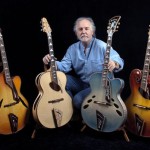
By Denise Mattia

John D’Angelicodeveloped out of this flourishing culture. The son of a tailor who lived on Mott Street, D’Angelico worked with his uncle, Raphael Ciani. When Ciani died, 18-year old D’Angelico continued to build instruments and, by the 1920s D’Angelico experimented with making archtop guitars, although none of his instruments have survived.
Borrowing designs from the famed Gibson L-5 in the early 1930s, D’Angelico’s instruments gained a reputation among players for having a balanced, full tone and a smoother sound than most other guitars. Among his many designs, the New Yorker was a larger-bodied instrument that echoed the ‘30s Art Deco period. Inlaid on the headstock of the guitar was a mother-of-pearl profile of the New Yorker Hotel.
D’Angelico’s protégée, James D’Aquisto worked for him from the 1950s until his death in 1964. Left with the workshop but without a reputation, D’Aquisto went through a series of legal mishaps, which led to his closing the New York workshop and moving to Long Island.
D’Aquisto continued to repair guitars and experiment on crafting them, altering the shape of the f-holes, the design of the headpiece and varying the colors of the varnish. He ultimately became an established luthier. In the late 1980s and early 1990s he introduced what is now referred to as his modern series (the Avant Garde, the Solo, the Centura, and the Advance), which dramatically changed the world of guitar making. He died in 1995 of an epileptic seizure.
Unlike D’Aquisito, who had apprenticed and inherited the workshop and clientele of D’Angelico after his death, John Monteleone had to make his own path. Influenced by both D’Aquisito and another master of lutherie, Mario Maccaferri, whose enterprise had grown in the 1940s to one of the major plastic manufacturing companies in the United States, Monteleone built a reputation as one of the great mandolin makers.
Toward the end of the 1980s the market for high-end archtops experienced resurgence, and Monteleone met the demands of a new generation of players. Over the past twenty years he has continued to build the very finest of archtop guitars and mandolins. Like D’Angelico, Monteleone has included Art Deco elements on his guitars, drawing inspiration from such landmarks as Radio City Music Hall, the Empire State and the Chrysler Building.
As stated in the museum’s introduction, “Monteleone has an extraordinary ability to combine a creative visual aesthetic with an astoundingly full and balanced sound to produce a masterpiece with each new instrument.”
Since becoming director of the Metropolitan Museum of Art in New York, Thomas P. Campbell has scheduled special exhibitions, which blend contemporary and modern works with ancient art and old masters. Last year viewers of every age and nationality were wowed by the Starn Brothers’ work titled Bambu, an interactive “Jungle Jim” created for the Met’s rooftop space and the American Woman: Fashioning a National Identity, an exhibit that focused on archetypes of the modern American woman from 1890 to 1940.
Currently, visitors are treated to more than a dozen special exhibits, among which are photographs from the 20th century (through April 10, 2011), ancient Roman mosaics from Lod (through April 3, 2011), 18th century treasures from the Forbidden City (through May 1, 2011) and Cezanne’s Card Players (through May 8, 2011).Open Sunday, Tuesday to Thursday 9:30 a.m. to 5:30 p.m. and Friday and Saturday 9:30 a.m. to 9:00 p.m., the Metropolitan Museum in New York continues to install special exhibitions that are educational, entertaining and challenging. Guitar Heroes, running through July 4th, 2011, is such a show.
About Theresa and Denise admin
- Web |
- More Posts (8)
